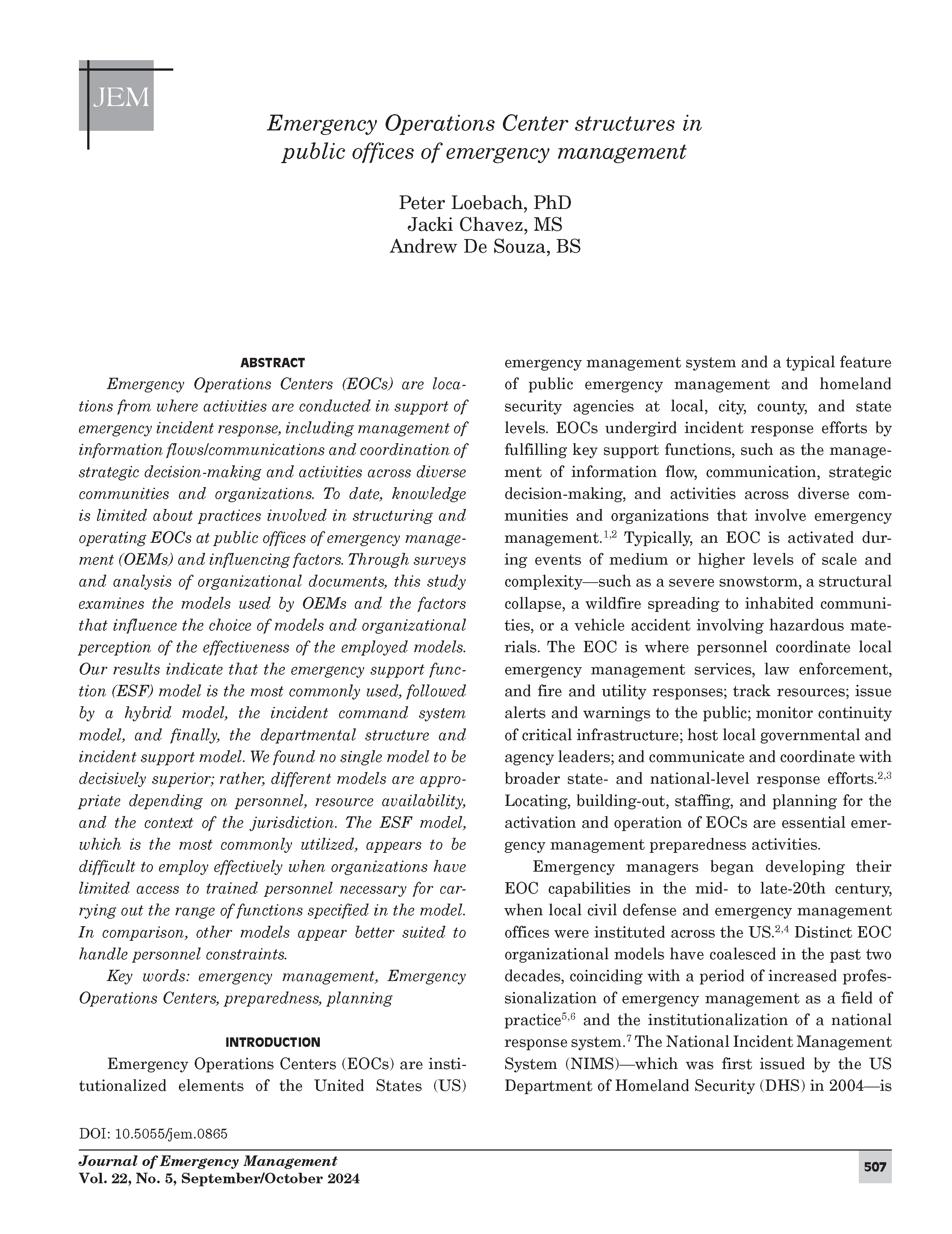Emergency Operations Center structures in public offices of emergency management
DOI:
https://doi.org/10.5055/jem.0865Keywords:
emergency management, Emergency Operations Centers, preparedness, planningAbstract
Emergency Operations Centers (EOCs) are locations from where activities are conducted in support of emergency incident response, including management of information flows/communications and coordination of strategic decision-making and activities across diverse communities and organizations. To date, knowledge is limited about practices involved in structuring and operating EOCs at public offices of emergency management (OEMs) and influencing factors. Through surveys and analysis of organizational documents, this study examines the models used by OEMs and the factors that influence the choice of models and organizational perception of the effectiveness of the employed models. Our results indicate that the emergency support function (ESF) model is the most commonly used, followed by a hybrid model, the incident command system model, and finally, the departmental structure and incident support model. We found no single model to be decisively superior; rather, different models are appropriate depending on personnel, resource availability, and the context of the jurisdiction. The ESF model, which is the most commonly utilized, appears to be difficult to employ effectively when organizations have limited access to trained personnel necessary for carrying out the range of functions specified in the model. In comparison, other models appear better suited to handle personnel constraints.
References
Neal DM, Phillips BD: Effective emergency management: Reconsidering the bureaucratic approach. Disasters. 1995; 19(4): 327-337. DOI: https://doi.org/10.1111/j.1467-7717.1995.tb00353.x
Quarantelli EL: Ten criteria for evaluating the management of community disasters. Disasters. 1997; 21(1): 39-56. DOI: https://doi.org/10.1111/1467-7717.00043
Rotanz RA: From research to praxis: The relevance of disaster research for emergency management. In Rodriguez H, Quarantelli EL, and Dynes R (eds.): Handbook of Disaster Research. New York, NY: Springer, 2007: 468-475. DOI: https://doi.org/10.1007/978-0-387-32353-4_28
Drabek TE: Managing the emergency response. Public Adm Rev. 1985; 45: 85-92. DOI: https://doi.org/10.2307/3135002
Cwiak C: Framing the future: What should emergency management graduates know? J Homeland Sec Emerg Manag. 2011; 8(2): 1-14. DOI: https://doi.org/10.2202/1547-7355.1910
Urby H, McEntire DA: Field, discipline, and profession: Understanding three major labels of emergency management. J Emerg Manag. 2015; 13(5): 389-400. DOI: https://doi.org/10.5055/jem.2015.0250
Jensen J, Thompson S: The incident command system: A literature review. Disasters. 2016; 40(1): 158-182. DOI: https://doi.org/10.1111/disa.12135
Federal Emergency Management Agency: National Incident Management System. 2008. Available at https://www.fema.gov/pdf/emergency/nims/NIMS_core.pdf. Accessed January 9, 2024.
Auf der Heide E: Disaster planning, part II: Disaster problems, issues, and challenges identified in the research literature. Emerg Med Clin. 1996; 14(2): 453-480. DOI: https://doi.org/10.1016/S0733-8627(05)70262-5
Comfort LK: Integrating organizational action in emergency management; strategies for change. Pubic Adm Rev. 1985; 45: 155-164. DOI: https://doi.org/10.2307/3135010
Perry RW: Emergency operations centres in an era of terrorism: Policy and management functions. J Contingencies Crisis Manag. 2003; 11(4): 151-159. DOI: https://doi.org/10.1111/j.0966-0879.2003.01104001.x
Scanlon J: The role of EOCs in emergency management: A comparison of American and Canadian experience. Int J Mass Emerg Disasters. 1994; 12(1): 53-75. DOI: https://doi.org/10.1177/028072709401200103
Sylves RT: Adopting integrated emergency management in the United States: Political and organizational challenges. Int J Mass Emerg Disasters. 1991; 9(3): 413-424. DOI: https://doi.org/10.1177/028072709100900308
Tierney KJ: Emergency medical preparedness and response in disasters: The need for interorganizational coordination. Public Adm Rev. 1985; 45: 77-84. DOI: https://doi.org/10.2307/3135001
Wenger DE, Dynes RR, Quarantelli EL: Disaster Analysis: Police and Fire Departments. Newark, DE: Disaster Research Center, University of Delaware, 1989.
Fagel MJ, Mathews RC, Murphy JH (eds.): Principles of Emergency Management and Emergency Operations Centers (EOC). Boca Raton, FL: CRC Press, 2021. DOI: https://doi.org/10.4324/9781315118345
Federal Emergency Management Agency (FEMA): National Incident Management System. Washington, DC: FEMA, 2004.
Federal Emergency Management Agency: Disaster Operations: A Handbook for Local Government. Washington, DC: FEMA, 1981.
Ryan M: Planning in the emergency operations center. Technol Forecast Soc Change. 2013; 80(9): 1725-1731. DOI: https://doi.org/10.1016/j.techfore.2013.01.006
Cavaliere P, Cox Z, Kendra J, et al.: A research agenda to explore the emergency operations center. J Emerg Manag. 2020; 18(6): 525-534. DOI: https://doi.org/10.5055/jem.2020.0499
Shrader KW: Designing an Effective Emergency Operations Center for the City of Martinsville, Virginia. Emmitsburg, MD: National Fire Academy, 2011.
Perry RW, Lindell MK: Preparedness for emergency response: Guidelines for the emergency planning process. Disasters. 2003; 27(4): 336-350. DOI: https://doi.org/10.1111/j.0361-3666.2003.00237.x
Militello LG, Patterson ES, Bowman L, et al.: Information flow during crisis management: Challenges to coordination in the emergency operations center. Cogn Technol Work. 2007; 9: 25-31. DOI: https://doi.org/10.1007/s10111-006-0059-3
Federal Emergency Management Agency: Emergency operations center skillsets user guide. 2018. Available at https://www.fema.gov/sites/default/files/2020-05/fema_nqs_eoc-skillset-guide_0.pdf. Accessed January 9, 2024.
Federal Emergency Management Agency: Emergency operations center how-to quick reference guide. 2022. Available at https://www.fema.gov/sites/default/files/documents/fema_eoc-quickreference-guide.pdf. Accessed January 9, 2024.
Jensen J, Waugh WL: The United States' experience with the incident command system: What we think we know and what we need to know more about. J Contingencies Crisis Manag. 2014; 22(1): 5-17. DOI: https://doi.org/10.1111/1468-5973.12034
Hanifen RW: Enhancing collaboration between fire departments and Emergency-Management Agencies (EMAs) in disaster management: Incident command system (ICS) versus collaboration theory. Int Fire Serv J Leadersh Manag. 2017; 11: 81-92.
Department of Homeland Security: Homeland Security Presidential Directive 5. Management of domestic incidents. Available at http://www.fas.org/irp/offdocs/nspd/hspd-5.html. Accessed January 9, 2024.
Larson RD: When ICS meets the EOC. J Homeland Protect Profess. 2007; 6(1): 14-18.
Lutz LD, Lindell MK: Incident command system as a response model within emergency operation centers during Hurricane Rita. J Contingencies Crisis Manag. 2008; 16(3): 122-134. DOI: https://doi.org/10.1111/j.1468-5973.2008.00541.x
Waugh WL, Streib G: Collaboration and leadership for effective emergency management. Public Adm Rev. 2006; 66: 131-140. DOI: https://doi.org/10.1111/j.1540-6210.2006.00673.x
Kapucu N, Okhai R, Hu Q: Network governance for coordinated disaster response. Public Adm Rev. 2022; 46(4): 309-333. DOI: https://doi.org/10.37808/paq.46.4.2
Federal Emergency Management Agency: National Response Framework. 4th ed. 2019. Available at https://www.fema.gov/sites/default/files/2020-04/NRF_FINALApproved_2011028.pdf. Accessed January 9, 2024.
Federal Emergency Management Agency: G0191 ICS/EOC Interface Workshop Manual. Emmitsburg, MD: FEMA, 2013.

Published
How to Cite
Issue
Section
License
Copyright 2007-2025, Weston Medical Publishing, LLC and Journal of Emergency Management. All Rights Reserved.
Leave Nobody Behind: Emergency Management in a More Inclusive Way is a trademark of Journal of Emergency Management





